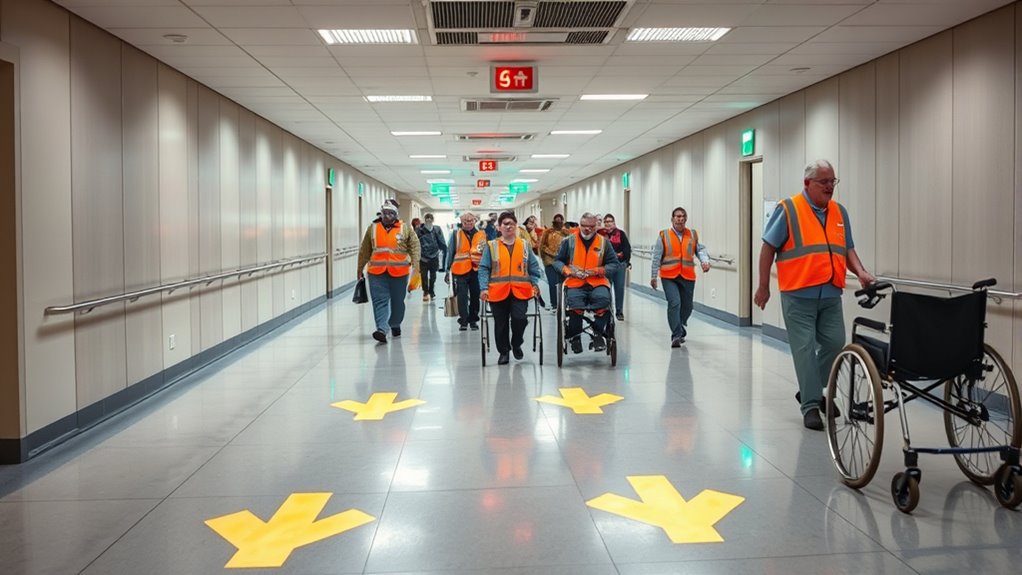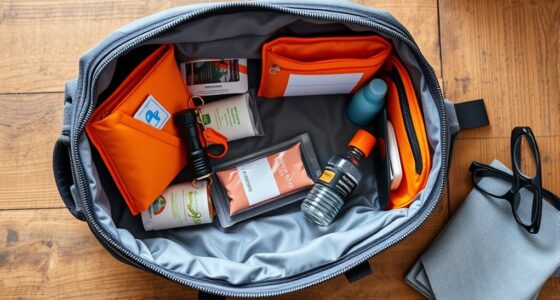To guarantee safe evacuation with mobility limitations, plan clear, accessible routes that avoid stairs and obstacles, leading to designated safe zones. Identify trusted helpers who understand your needs and practice evacuation drills together regularly. Keep maps and instructions handy, and set up a system for quick communication. Familiarity with your routes and helpers reduces panic and delays. Keep exploring how to refine your plan for maximum safety during emergencies.
Key Takeaways
- Map out accessible evacuation routes avoiding stairs and obstacles, leading to designated safe zones suited for mobility aids.
- Identify and train reliable helpers familiar with specific mobility needs and evacuation procedures.
- Regularly practice evacuation drills with helpers to ensure quick, confident responses during emergencies.
- Keep physical maps, written instructions, and emergency contacts accessible in multiple locations.
- Establish clear communication methods for alerting helpers and requesting assistance promptly during an emergency.

When emergencies strike, having a well-designed evacuation plan is essential, especially for individuals with mobility limitations. You need to know exactly how to exit safely and efficiently, minimizing confusion and delays. The first step is mapping out clear, accessible routes that cater to your specific needs. These routes should avoid stairs, narrow doorways, or obstacles that could hinder your movement. Instead, they should lead to designated safe zones or exits that are easy to reach with mobility aids like wheelchairs, walkers, or canes. It’s important to familiarize yourself with these routes regularly, so in a real emergency, you can move quickly and confidently. Keep a physical map or written instructions in accessible locations, such as near your bed or in your emergency kit, so you can reference them when needed.
In addition to planning your routes, identify who can assist you during an evacuation. Relying on helpers is essential, especially if your mobility limitations prevent you from moving quickly or independently. These helpers could include family members, friends, neighbors, or designated emergency personnel trained to assist individuals with disabilities. Make sure everyone involved understands your specific needs and the best way to help you. Practice evacuating with your helpers periodically, so they’re familiar with your mobility equipment and your preferred routes. This also reassures you that everyone knows their role, reducing panic during an actual emergency.
Communication is important. Establish a clear plan for alerting your helpers when an emergency occurs, whether it’s through a phone call, text, or signaling device. Some communities have designated alert systems for people with disabilities, so find out if such resources are available to you. It’s a good idea to keep a list of emergency contacts and helpers in your wallet, home, and phone. Also, consider using visual or auditory signals to alert others if you need assistance.
Frequently Asked Questions
How Often Should Evacuation Plans Be Reviewed and Updated?
You should review and update your evacuation plans at least once a year, or whenever there’s a significant change in your mobility needs, household composition, or local conditions. Regular reviews ensure your plan remains effective and relevant. It’s also wise to practice drills periodically, so you stay familiar with procedures and can make adjustments based on any challenges or new information. Staying proactive helps keep everyone safe during emergencies.
What Training Is Recommended for Evacuation Helpers?
You should train helpers in clear communication, gentle guiding, and emergency procedures, turning them into steady anchors in chaos. Practice role-playing scenarios to build confidence and guarantee they can navigate obstacles smoothly. Equip them with knowledge of mobility aids, first aid, and evacuation routes. Regular drills keep their skills sharp, like a well-tuned instrument, so when disaster strikes, they’re ready to lead with calm, purpose, and compassion.
Are There Specific Evacuation Routes for Different Mobility Impairments?
Yes, there are specific evacuation routes tailored for various mobility impairments. You should familiarize yourself with designated accessible pathways that accommodate wheelchairs, walkers, or other mobility aids. These routes often include ramps, elevators, or level surfaces. It’s essential to work with local emergency services or facility managers to identify and practice these routes, ensuring you can evacuate safely and efficiently during an emergency.
How Can Technology Assist in Evacuation Planning for Mobility Limitations?
Technology can greatly enhance evacuation planning for mobility limitations. For example, a city could use an app that maps accessible routes and connects you with nearby helpers during emergencies. Imagine receiving real-time updates on safest paths tailored to your needs, ensuring swift evacuation. This way, you stay informed, connected, and supported, making emergency responses more efficient and inclusive for everyone with mobility challenges.
What Resources Are Available for Funding Evacuation Improvements?
You can explore federal grants like FEMA’s Emergency Management Performance Grants (EMPG) and Homeland Security Grants, which fund evacuation improvements. Local government budgets and nonprofit organizations also offer financial support for accessibility upgrades. Additionally, you might seek private donations or community fundraising efforts. Partnering with agencies that specialize in disability services can help identify funding opportunities, ensuring your evacuation plans meet mobility needs and improve safety during emergencies.
Conclusion
Now that you know how vital tailored evacuation plans are, won’t you take the steps to guarantee everyone’s safety? By knowing the routes and enlisting helpers, you create a safer environment for those with mobility limitations. Isn’t it worth the effort to make sure no one is left behind in an emergency? Planning ahead not only saves lives but also builds a community where everyone feels protected and included. Are you ready to take action today?









